Ying Cheng
MovieCORE: COgnitive REasoning in Movies
Aug 26, 2025



Abstract:This paper introduces MovieCORE, a novel video question answering (VQA) dataset designed to probe deeper cognitive understanding of movie content. Unlike existing datasets that focus on surface-level comprehension, MovieCORE emphasizes questions that engage System-2 thinking while remaining specific to the video material. We present an innovative agentic brainstorming approach, utilizing multiple large language models (LLMs) as thought agents to generate and refine high-quality question-answer pairs. To evaluate dataset quality, we develop a set of cognitive tests assessing depth, thought-provocation potential, and syntactic complexity. We also propose a comprehensive evaluation scheme for assessing VQA model performance on deeper cognitive tasks. To address the limitations of existing video-language models (VLMs), we introduce an agentic enhancement module, Agentic Choice Enhancement (ACE), which improves model reasoning capabilities post-training by up to 25%. Our work contributes to advancing movie understanding in AI systems and provides valuable insights into the capabilities and limitations of current VQA models when faced with more challenging, nuanced questions about cinematic content. Our project page, dataset and code can be found at https://joslefaure.github.io/assets/html/moviecore.html.
FineMedLM-o1: Enhancing the Medical Reasoning Ability of LLM from Supervised Fine-Tuning to Test-Time Training
Jan 16, 2025Abstract:Recent advancements in large language models (LLMs) have shown promise in medical applications such as disease diagnosis and treatment planning. However, most existing medical LLMs struggle with the advanced reasoning required for complex clinical scenarios, such as differential diagnosis or personalized treatment suggestions. We proposed FineMedLM-o1, which leverages high-quality synthetic medical data and long-form reasoning data for Supervised Fine-Tuning (SFT) and Direct Preference Optimization (DPO), enabling advanced dialogue and deep reasoning capabilities. Additionally, we introduced Test-Time Training (TTT) in the medical domain for the first time, facilitating domain adaptation and ensuring reliable, accurate reasoning. Experimental results demonstrate that FineMedLM-o1 achieves a 23% average performance improvement over prior models on key medical benchmarks. Furthermore, the introduction of TTT provides an additional 14% performance boost, highlighting its effectiveness in enhancing medical reasoning capabilities. To support this process, we also proposed a novel method for synthesizing medical dialogue. Compared to other open-source datasets, our dataset stands out as superior in both quality and complexity. The project and data will be released on GitHub.
CT2C-QA: Multimodal Question Answering over Chinese Text, Table and Chart
Oct 28, 2024Abstract:Multimodal Question Answering (MMQA) is crucial as it enables comprehensive understanding and accurate responses by integrating insights from diverse data representations such as tables, charts, and text. Most existing researches in MMQA only focus on two modalities such as image-text QA, table-text QA and chart-text QA, and there remains a notable scarcity in studies that investigate the joint analysis of text, tables, and charts. In this paper, we present C$\text{T}^2$C-QA, a pioneering Chinese reasoning-based QA dataset that includes an extensive collection of text, tables, and charts, meticulously compiled from 200 selectively sourced webpages. Our dataset simulates real webpages and serves as a great test for the capability of the model to analyze and reason with multimodal data, because the answer to a question could appear in various modalities, or even potentially not exist at all. Additionally, we present AED (\textbf{A}llocating, \textbf{E}xpert and \textbf{D}esicion), a multi-agent system implemented through collaborative deployment, information interaction, and collective decision-making among different agents. Specifically, the Assignment Agent is in charge of selecting and activating expert agents, including those proficient in text, tables, and charts. The Decision Agent bears the responsibility of delivering the final verdict, drawing upon the analytical insights provided by these expert agents. We execute a comprehensive analysis, comparing AED with various state-of-the-art models in MMQA, including GPT-4. The experimental outcomes demonstrate that current methodologies, including GPT-4, are yet to meet the benchmarks set by our dataset.
ADSNet: Cross-Domain LTV Prediction with an Adaptive Siamese Network in Advertising
Jun 15, 2024



Abstract:Advertising platforms have evolved in estimating Lifetime Value (LTV) to better align with advertisers' true performance metric. However, the sparsity of real-world LTV data presents a significant challenge to LTV predictive model(i.e., pLTV), severely limiting the their capabilities. Therefore, we propose to utilize external data, in addition to the internal data of advertising platform, to expand the size of purchase samples and enhance the LTV prediction model of the advertising platform. To tackle the issue of data distribution shift between internal and external platforms, we introduce an Adaptive Difference Siamese Network (ADSNet), which employs cross-domain transfer learning to prevent negative transfer. Specifically, ADSNet is designed to learn information that is beneficial to the target domain. We introduce a gain evaluation strategy to calculate information gain, aiding the model in learning helpful information for the target domain and providing the ability to reject noisy samples, thus avoiding negative transfer. Additionally, we also design a Domain Adaptation Module as a bridge to connect different domains, reduce the distribution distance between them, and enhance the consistency of representation space distribution. We conduct extensive offline experiments and online A/B tests on a real advertising platform. Our proposed ADSNet method outperforms other methods, improving GINI by 2$\%$. The ablation study highlights the importance of the gain evaluation strategy in negative gain sample rejection and improving model performance. Additionally, ADSNet significantly improves long-tail prediction. The online A/B tests confirm ADSNet's efficacy, increasing online LTV by 3.47$\%$ and GMV by 3.89$\%$.
Modality-Aware Contrastive Instance Learning with Self-Distillation for Weakly-Supervised Audio-Visual Violence Detection
Jul 12, 2022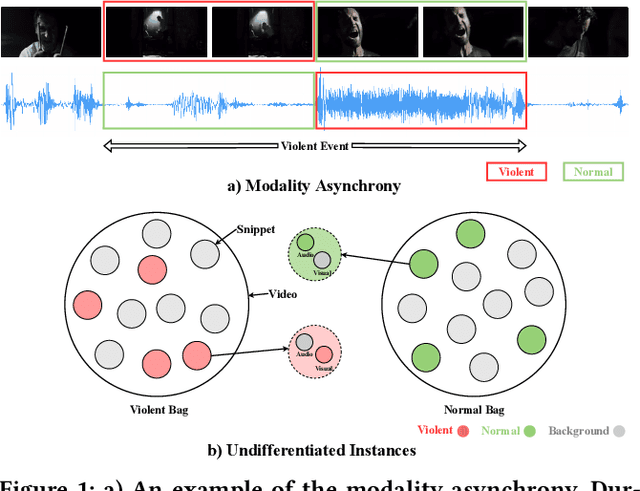
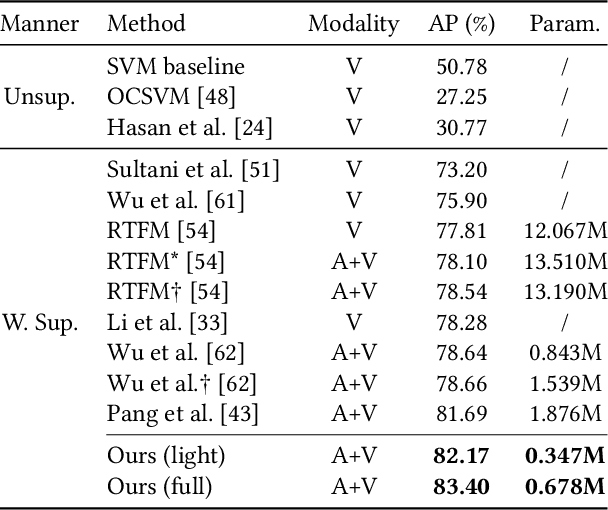
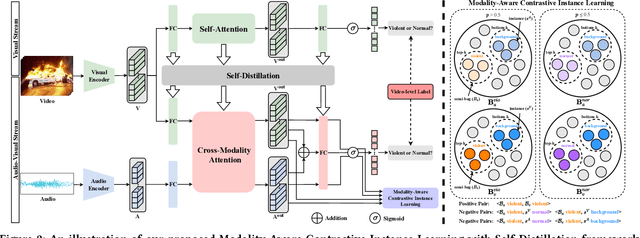
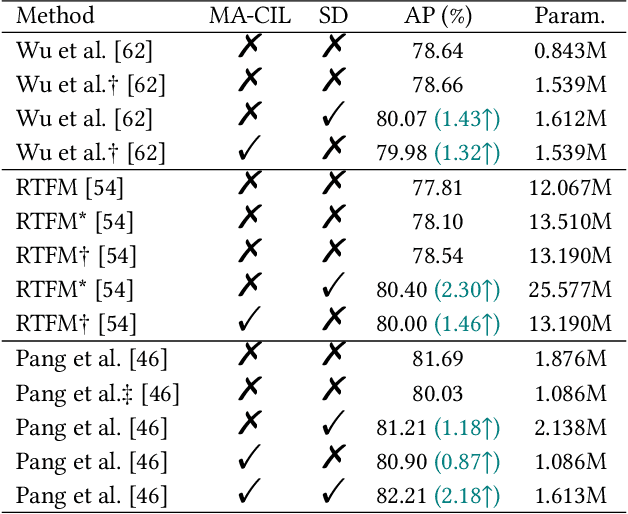
Abstract:Weakly-supervised audio-visual violence detection aims to distinguish snippets containing multimodal violence events with video-level labels. Many prior works perform audio-visual integration and interaction in an early or intermediate manner, yet overlooking the modality heterogeneousness over the weakly-supervised setting. In this paper, we analyze the modality asynchrony and undifferentiated instances phenomena of the multiple instance learning (MIL) procedure, and further investigate its negative impact on weakly-supervised audio-visual learning. To address these issues, we propose a modality-aware contrastive instance learning with self-distillation (MACIL-SD) strategy. Specifically, we leverage a lightweight two-stream network to generate audio and visual bags, in which unimodal background, violent, and normal instances are clustered into semi-bags in an unsupervised way. Then audio and visual violent semi-bag representations are assembled as positive pairs, and violent semi-bags are combined with background and normal instances in the opposite modality as contrastive negative pairs. Furthermore, a self-distillation module is applied to transfer unimodal visual knowledge to the audio-visual model, which alleviates noises and closes the semantic gap between unimodal and multimodal features. Experiments show that our framework outperforms previous methods with lower complexity on the large-scale XD-Violence dataset. Results also demonstrate that our proposed approach can be used as plug-in modules to enhance other networks. Codes are available at https://github.com/JustinYuu/MACIL_SD.
IDEA: Increasing Text Diversity via Online Multi-Label Recognition for Vision-Language Pre-training
Jul 12, 2022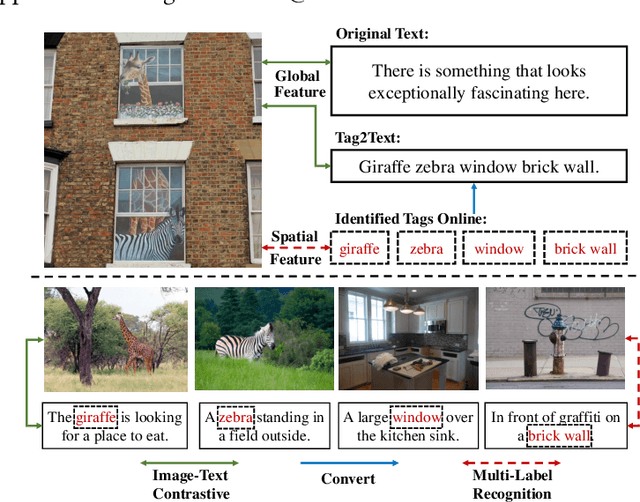



Abstract:Vision-Language Pre-training (VLP) with large-scale image-text pairs has demonstrated superior performance in various fields. However, the image-text pairs co-occurrent on the Internet typically lack explicit alignment information, which is suboptimal for VLP. Existing methods proposed to adopt an off-the-shelf object detector to utilize additional image tag information. However, the object detector is time-consuming and can only identify the pre-defined object categories, limiting the model capacity. Inspired by the observation that the texts incorporate incomplete fine-grained image information, we introduce IDEA, which stands for increasing text diversity via online multi-label recognition for VLP. IDEA shows that multi-label learning with image tags extracted from the texts can be jointly optimized during VLP. Moreover, IDEA can identify valuable image tags online to provide more explicit textual supervision. Comprehensive experiments demonstrate that IDEA can significantly boost the performance on multiple downstream datasets with a small extra computational cost.
Self-Supervised Learning of Music-Dance Representation through Explicit-Implicit Rhythm Synchronization
Jul 07, 2022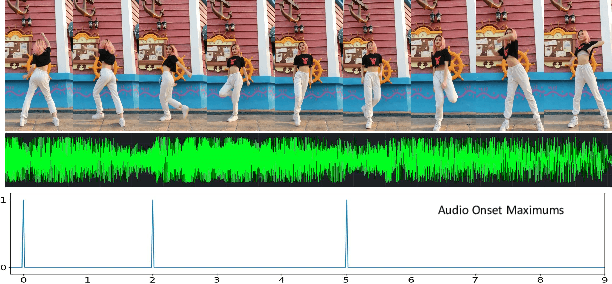
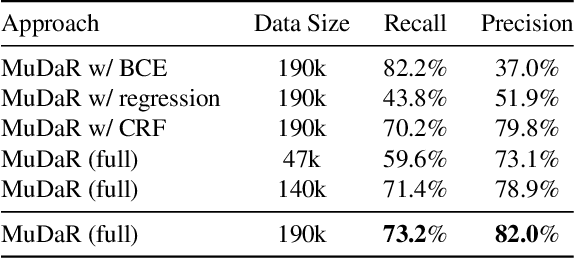
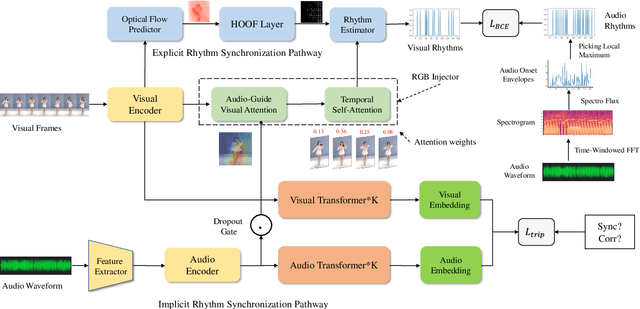
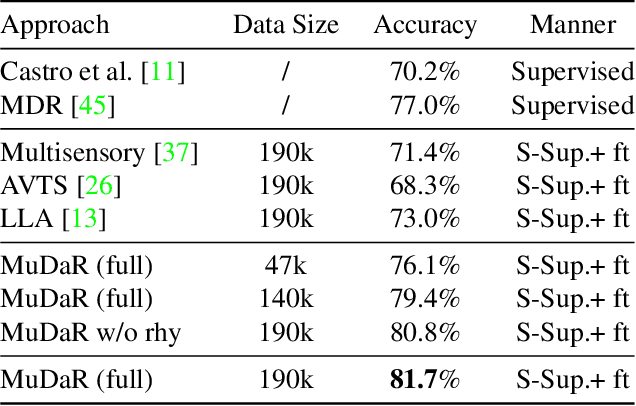
Abstract:Although audio-visual representation has been proved to be applicable in many downstream tasks, the representation of dancing videos, which is more specific and always accompanied by music with complex auditory contents, remains challenging and uninvestigated. Considering the intrinsic alignment between the cadent movement of dancer and music rhythm, we introduce MuDaR, a novel Music-Dance Representation learning framework to perform the synchronization of music and dance rhythms both in explicit and implicit ways. Specifically, we derive the dance rhythms based on visual appearance and motion cues inspired by the music rhythm analysis. Then the visual rhythms are temporally aligned with the music counterparts, which are extracted by the amplitude of sound intensity. Meanwhile, we exploit the implicit coherence of rhythms implied in audio and visual streams by contrastive learning. The model learns the joint embedding by predicting the temporal consistency between audio-visual pairs. The music-dance representation, together with the capability of detecting audio and visual rhythms, can further be applied to three downstream tasks: (a) dance classification, (b) music-dance retrieval, and (c) music-dance retargeting. Extensive experiments demonstrate that our proposed framework outperforms other self-supervised methods by a large margin.
Self-Supervised Video Representation Learning with Motion-Contrastive Perception
Apr 10, 2022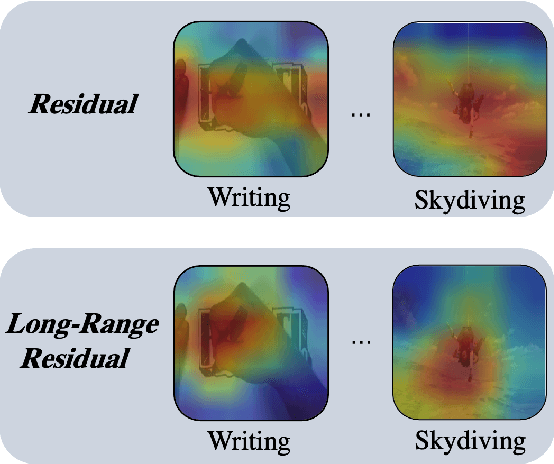
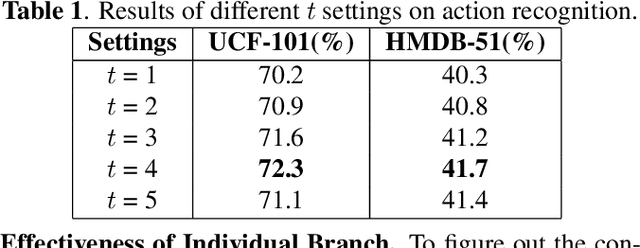
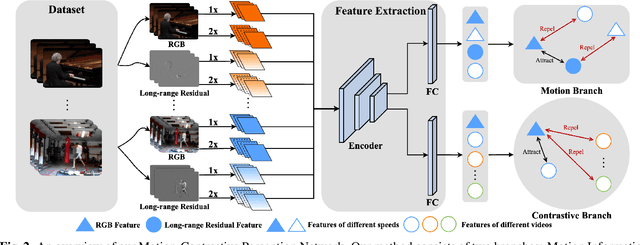
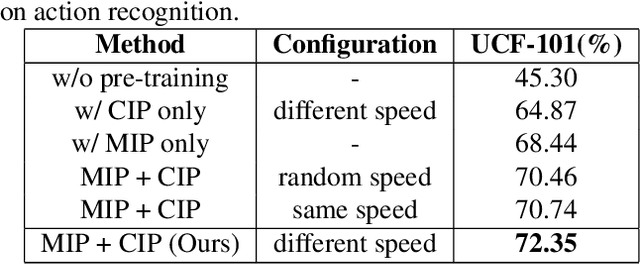
Abstract:Visual-only self-supervised learning has achieved significant improvement in video representation learning. Existing related methods encourage models to learn video representations by utilizing contrastive learning or designing specific pretext tasks. However, some models are likely to focus on the background, which is unimportant for learning video representations. To alleviate this problem, we propose a new view called long-range residual frame to obtain more motion-specific information. Based on this, we propose the Motion-Contrastive Perception Network (MCPNet), which consists of two branches, namely, Motion Information Perception (MIP) and Contrastive Instance Perception (CIP), to learn generic video representations by focusing on the changing areas in videos. Specifically, the MIP branch aims to learn fine-grained motion features, and the CIP branch performs contrastive learning to learn overall semantics information for each instance. Experiments on two benchmark datasets UCF-101 and HMDB-51 show that our method outperforms current state-of-the-art visual-only self-supervised approaches.
MM-Pyramid: Multimodal Pyramid Attentional Network for Audio-Visual Event Localization and Video Parsing
Nov 24, 2021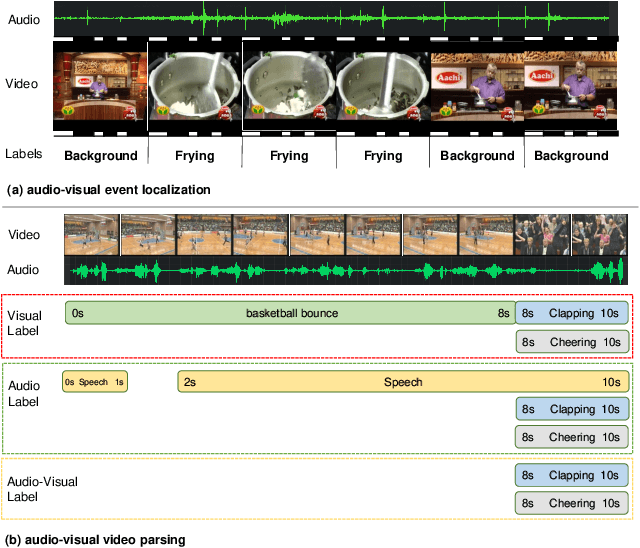
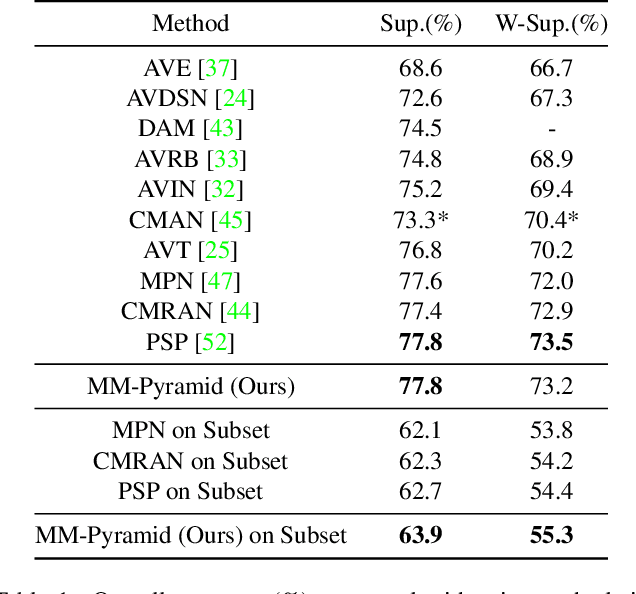
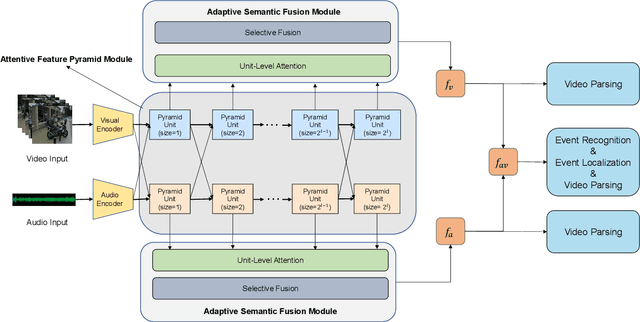
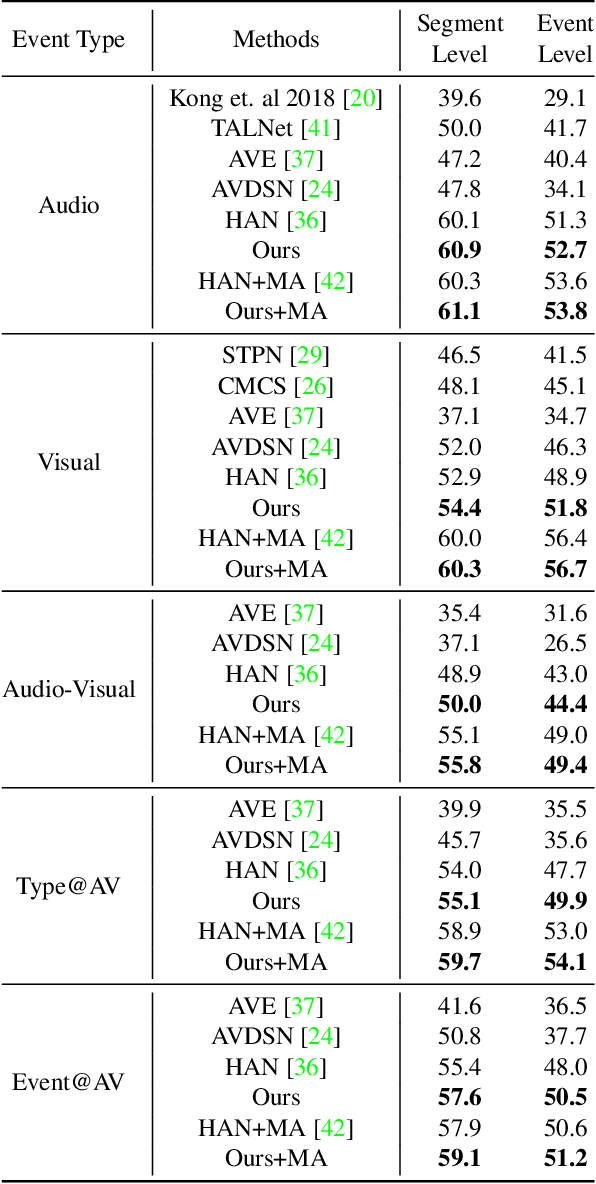
Abstract:Recognizing and localizing events in videos is a fundamental task for video understanding. Since events may occur in auditory and visual modalities, multimodal detailed perception is essential for complete scene comprehension. Most previous works attempted to analyze videos from a holistic perspective. However, they do not consider semantic information at multiple scales, which makes the model difficult to localize events in various lengths. In this paper, we present a Multimodal Pyramid Attentional Network (MM-Pyramid) that captures and integrates multi-level temporal features for audio-visual event localization and audio-visual video parsing. Specifically, we first propose the attentive feature pyramid module. This module captures temporal pyramid features via several stacking pyramid units, each of them is composed of a fixed-size attention block and dilated convolution block. We also design an adaptive semantic fusion module, which leverages a unit-level attention block and a selective fusion block to integrate pyramid features interactively. Extensive experiments on audio-visual event localization and weakly-supervised audio-visual video parsing tasks verify the effectiveness of our approach.
Domain Adaptive Cascade R-CNN for MItosis DOmain Generalization Challenge
Sep 29, 2021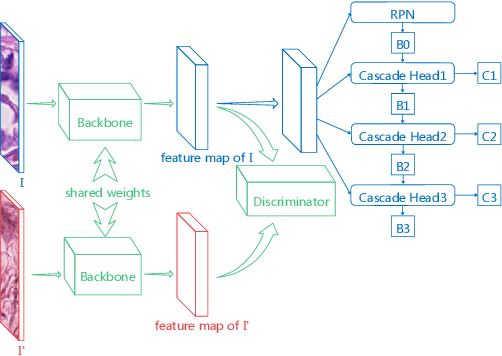
Abstract:We present a summary of the domain adaptive cascade R-CNN method for mitosis detection of digital histopathology images. By comprehensive data augmentation and adapting existing popular detection architecture, our proposed method has achieved an F1 score of 0.7500 on the preliminary test set in MItosis DOmain Generalization (MIDOG) Challenge at MICCAI 2021.
 Add to Chrome
Add to Chrome Add to Firefox
Add to Firefox Add to Edge
Add to Edge